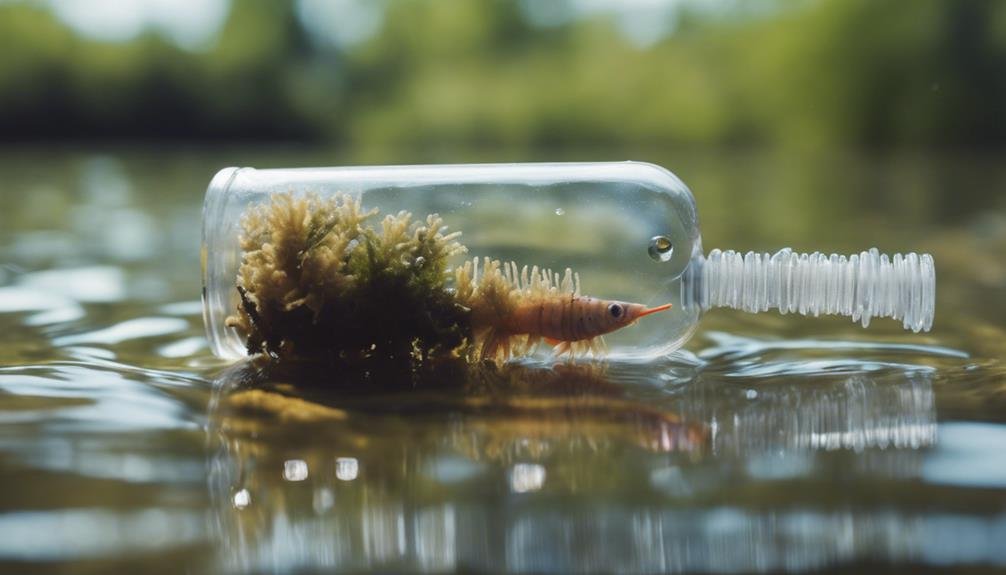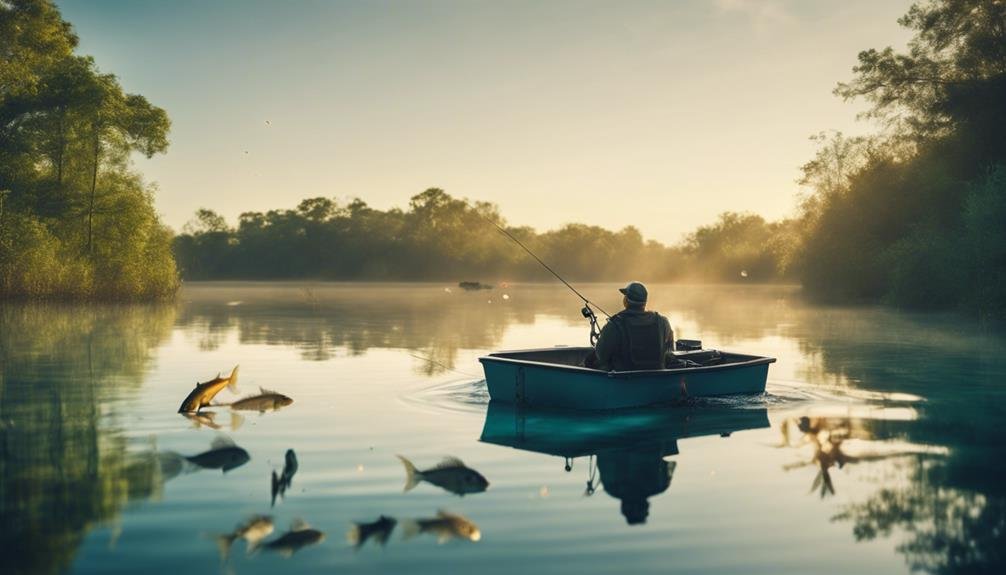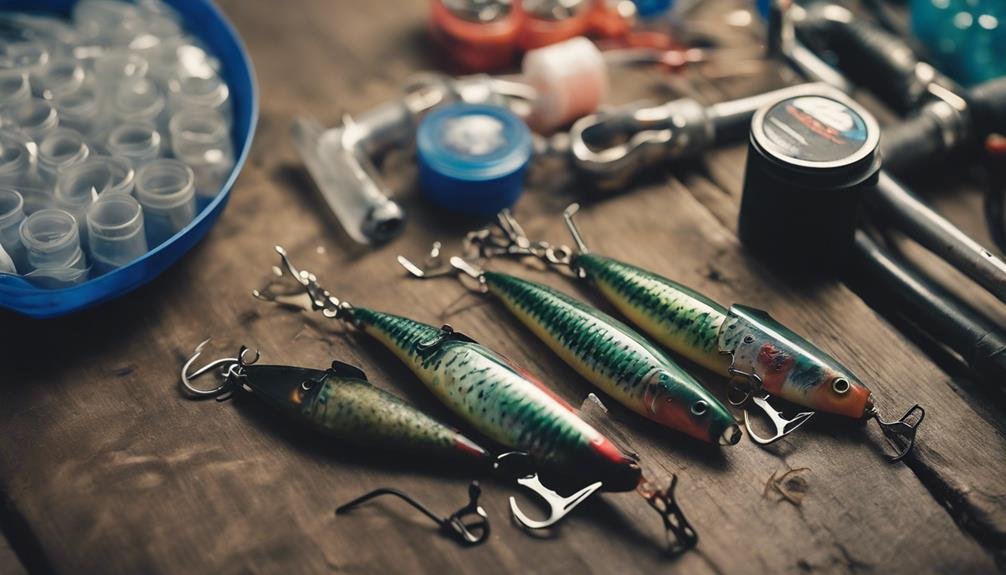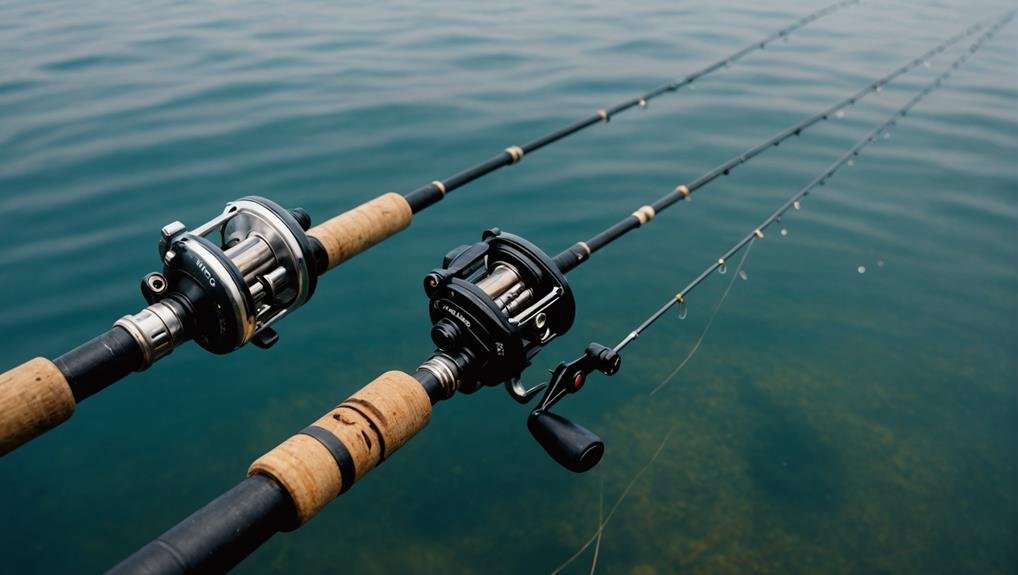When deciding between a Texas Rig and a Carolina Rig, you need to consider how each one works and where it performs best. The Texas Rig, with its snug bullet weight, is ideal for maneuvering through thick cover, while the Carolina Rig excels in open water with its sliding weight and leader line. Your choice hinges on the environment and the movement style you want. But what if you could master using both in different conditions? Keep going to explore how each rig can give you an edge on your next fishing trip.
Key Takeaways
- Texas rig is ideal for heavy cover, while the Carolina rig excels in open-water scenarios.
- Texas rig’s weight stays close to the lure for precise vertical movements.
- Carolina rig separates the weight from the lure, allowing subtle horizontal glides.
- Use a Texas rig for bed fishing in spring and snag-prone environments.
- Carolina rig is effective in deep waters and targets less aggressive, pressured fish.
Texas Rig Overview

The Texas rig, consisting of bullet weight, hook, and soft plastic bait, is a go-to setup for targeting bass in heavy cover. This rigging style excels when fishing in areas with vegetation or other obstacles. By utilizing a bullet weight, you guarantee your bait can penetrate through dense cover without getting snagged, making it perfect for those high-pressure fishing days when the bass is hiding.
You’ll often find yourself pitching and flipping your Texas rig into tight spots. This technique lets you drop your soft plastic bait right into the heart of the cover, where bass love to hide. The weedless presentation ensures you won’t spend your day untangling your line from underwater debris.
Many anglers prefer to peg the bullet weight when fishing in heavy cover. Pegging helps keep the weight close to the bait, improving accuracy and preventing the rig from getting caught up in weeds. This setup is particularly effective during the spawn when bass are on beds, and precision is key.
Whether you’re working shallow flats or deeper structures, the Texas rig offers versatility and effectiveness, making it a staple in any bass angler’s arsenal.
Carolina Rig Overview
Switching gears from the Texas rig, let’s explore the Carolina rig, which is renowned for its effectiveness in open-water scenarios. This rig involves a sliding weight, swivel, beads, leader line, hook, and a soft plastic lure. It’s designed to cover water horizontally, making it perfect for fishing in areas like flats and humps.
The Carolina rig’s subtle movements make fishing particularly enticing, especially in clear or high-pressure waters. Using a longer leader can enhance the bait’s natural presentation, preventing bass and other fish from feeling the weight. This versatile setup attracts various species beyond just bass, making it a go-to choice for many anglers.
Here are three key aspects that make the Carolina rig so effective:
- Horizontal Coverage: You can cover more water and target fish spread over larger areas.
- Natural Presentation: Longer leaders help make the soft plastic lure appear lifelike, boosting your bite chances.
- Versatility: Suitable for different environments and a range of fish species, not just bass.
Key Differences

When comparing Texas rigs and Carolina rigs, you’ll notice key differences in weight placement and how each rig presents and moves in the water.
Texas rigs keep the weight close to the lure, making it great for precise, vertical movements.
Carolina rigs have the weight separated from the lure, allowing for subtle, horizontal glides that attract fish in open water.
Weight Placement Variations
Understanding the weight placement variations between Texas and Carolina rigs can greatly enhance your fishing strategy. In the Carolina Rig vs Texas debate, one key difference lies in how the weight is positioned.
The Texas rig’s weight directly above the hook makes it perfect for a bottom-oriented presentation. This setup allows you to place your bait in heavy cover without getting snagged precisely.
On the other hand, the Carolina rig utilizes a sliding weight positioned farther up the line from the hook. This placement provides more natural movement and floats for your bait, which can be particularly effective in open water or sparse cover.
Weight placement impacts your fishing in several ways:
- Lure Action: Texas rigs offer a more controlled and precise lure action, while Carolina rigs allow for more natural movement.
- Depth Control: The weight on a Texas rig keeps your bait close to the bottom, which is ideal for bottom-dwelling fish. Carolina rigs let your bait float slightly above the bottom.
- Casting Distance: The sliding weight on a Carolina rig can increase casting distance, whereas a Texas rig’s fixed weight is better for short, accurate casts in dense cover.
Presentation and Movement
The choice between a Texas rig and a Carolina rig often boils down to how you want to present and move your bait in the water. With Texas rigs, you’re looking at precise bait placement and maneuverability, making them perfect for flipping and pitching into cover. This setup excels when you must drag your lure along the bottom, easily getting in and out of snag-prone areas. Texas rigs are your go-to if you’re dealing with heavy vegetation or complex bottom composition.
On the other hand, Carolina rigs are all about covering more water and presenting your bait horizontally. This rig is ideal for open water areas like humps and flats, where you can drag your lure around structures and entice fish with subtle, natural movements. The Carolina rig’s leader allows the bait to float and move more freely, mimicking the natural movement of prey.
Best Uses for Texas Rigs
Texas rigs shine in snag-prone environments, allowing you to easily manage lures through heavy cover. Whether fishing in thick brush piles or heavy vegetation, the Texas rig’s weedless design guarantees you can present your bait without getting tangled. This makes it perfect for target fishing situations where precision is vital.
Here are three best uses for Texas rigs:
- Fishing in Heavy Cover: The Texas rig excels in areas with vegetation, submerged timber, or brush piles. This setup allows you to target fish hiding in these structures, where other rigs might get snagged.
- Flipping and Pitching: The Texas rig is unparalleled for techniques like flipping and pitching. It lets you accurately drop your bait into tight spots, whether fishing in cover or open water. This is essential for enticing fish hiding in small pockets that require precise presentations.
- Bed Fishing: In the spring, the Texas rig is a go-to choice for targeting fish on beds. Its ability to drag along the bottom and stay weedless ensures you present your bait right where the fish are nesting, increasing your chances of a successful catch.
Best Uses for Carolina Rigs

The Carolina rig shines when you aim to cover large areas or fish deep waters. Its horizontal presentation is perfect for detecting subtle bites and works wonders in open water.
Use it to target pressured fish around structures or vegetation-rich areas efficiently and efficiently.
Deep Water Fishing
In deep-water fishing, Carolina rigs are your go-to setup for long casts and precise bait placement. Unlike Texas rigs, which struggle to reach deeper depths, Carolina rigs excel in these challenging conditions. The sliding weight on a Carolina rig guarantees your bait dives deep and stays in the strike zone longer, making it ideal for offshore areas.
Here are three key reasons to use Carolina rigs in deep water:
- Targeting Deep Structures: Carolina rigs are perfect for fishing around deep structures like humps, ledges, and offshore flats. The weight helps your bait navigate these areas effectively.
- Natural Presentation: The subtle, natural movement of the bait on a Carolina rig can entice even the most pressured fish to strike. This is important in deep water, where fish may be more cautious.
- Horizontal Coverage: The Carolina rig’s design allows you to cover more water horizontally, which is beneficial when locating schools of fish in vast, deep-water environments.
When you’re out for deep water fishing, don’t underestimate the power of a Carolina rig. It’s versatile, effective, and can turn a tough day on the water into a successful one.
Covering Large Areas
Carolina rigs are essential for covering large water areas, making them ideal for locating and targeting fish spread across expansive zones. When you’re fishing in open water environments like flats, humps, and points, a Carolina rig excels at presenting your bait horizontally. This is vital for enticing fish that might be spread out over a wide range. The beauty of the Carolina rig lies in its ability to mimic natural prey movements, thanks to the sliding weight setup.
The sliding weight allows your bait to move freely, creating subtle movements that can effectively lure fish from a distance. This setup is particularly advantageous when fish are scattered or moving around. Covering large areas efficiently increases your chances of encountering and catching more fish.
When fishing in open water, the Carolina rig’s design ensures that your bait stays close to the bottom while still moving naturally. This makes it an excellent choice for fish less likely to strike at fast-moving lures.
Detecting Subtle Bites
Detecting subtle bites becomes much easier with a Carolina rig, especially when targeting finicky or pressured fish. The unique design of the Carolina rig, with its long leader and soft plastic bait, allows for a natural presentation that hesitant fish find hard to resist. This setup is particularly effective in deep water where fish mightn’t be as aggressive or actively feeding.
Here are three reasons why the Carolina rig excels at detecting subtle bites:
- Natural Presentation: The long leader on a Carolina rig lets your soft plastic bait move freely, mimicking the natural motion of prey. Fish are less likely to feel the weight, making them more inclined to commit to delicate bites.
- Sensitivity: The Carolina rig’s design transmits even the slightest nibble up the line, allowing you to detect subtle bites more easily. This is important when fishing in clear or high-pressure waters where fish are extra careful.
- Versatility: Whether fishing in deep water or maneuvering through various structures, the Carolina rig adapts well, giving you the confidence to detect and react to even the most delicate bites.
Using a Carolina rig can significantly increase your chances of success, especially when dealing with finicky fish.
Seasonal Considerations
When planning your fishing strategy, adjusting your rig based on the season can greatly boost your chances of success. In the spring, fish a Texas rig for bed fishing, allowing you to target bass effectively.
Conversely, the Carolina rig should be used often for pre-spawn staging fish, as it helps cover water quickly and locate active fish.
As summer heats up, the Carolina rig excels in catching schooling fish. Its ability to present a little heavier and deeper bait is perfect for drawing strikes from fish in deeper water.
Meanwhile, the Texas rig remains effective for offshore cover fishing, giving you precise bait placement around structures where bass hide from the heat.
In the fall, the Texas rig shines for its precision, which is ideal for targeting bass on beds. At the same time, the Carolina rig works well in vegetation, allowing you to reach fish hiding in thick cover.
Modifications and Tips

Enhancing your Texas or Carolina rig with specific modifications can improve your fishing success. For the Texas rig, try using lighter weights to increase the bait’s action in sparse cover. This simple change can make your lure more enticing to fish.
Pegging the weight is another crucial modification, particularly in heavy cover, to prevent snagging and guarantee your bait reaches the desired depth.
With the Carolina rig, consider using a swivel tied with a Palomar knot. This enhances the flexibility of your leader line and improves durability. Adding beads to both rigs can create additional noise, attracting fish in murky waters or during low-light conditions.
Here are three key modifications to elevate your rigging game:
- Use Lighter Weights on Texas Rig: Opt for lighter tungsten weights to enhance lure action in sparse cover.
- Swivel and Palomar Knot on Carolina Rig: A swivel tied with a Palomar knot improves leader line flexibility and durability.
- Add Beads for Noise: Incorporate beads on either rig to generate noise and attract more fish.
Conclusion
Choosing between the Texas and Carolina Rig depends on your fishing conditions and goals. The Texas Rig is best for heavy cover and precise vertical movements, while the Carolina Rig excels in open water with horizontal glides.
Understanding their strengths will help you make better decisions on the water. Adapting your rig to the environment and fish behavior is key to a successful fishing trip.
Happy fishing!
FAQs
Which Is Better, Carolina Rig or Texas Rig?
When deciding which rig is better, consider weight differences, casting distance, hook size, bait movement, and weed control. Carolina rigs excel in open water with long casts, while Texas rigs shine in cover with precise bait placement.
What Is a Carolina Rig Good For?
A Carolina rig is great for deep-water fishing and maneuvering through weedless structures. You can adjust the weight choice for different bottom contours and achieve a natural bait presentation, enticing fish with subtle movements.
When Should You Use a Texas Rig?
Use a Texas rig when precise bait placement is essential. Adjust your hook size and bait choice based on water clarity, fishing depth, and seasonal patterns. This rig is perfect for heavy cover and vegetation in shallow and deep waters.
Can You Texas Rig With a Regular Hook?
You can use a Youg with regular hook types, such as offset worm or straight shank hooks. For the best results, choose the right bait, use proper rigging techniques, and match your line strength to your fishing spots.

